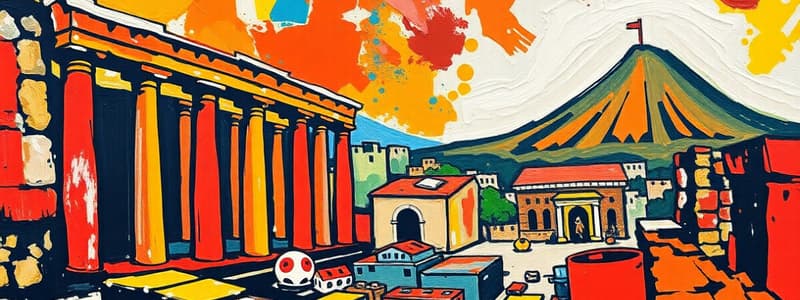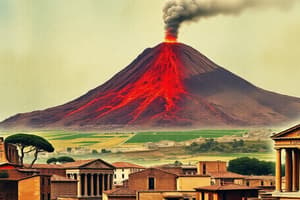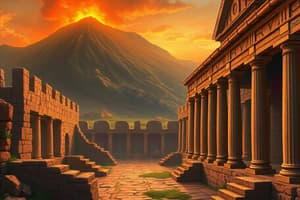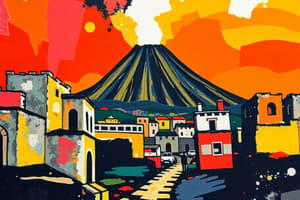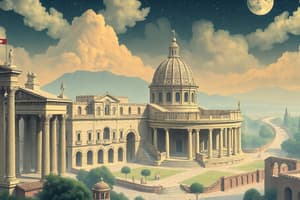Podcast
Questions and Answers
Why did archaeologists initially believe that the residents of Herculaneum had escaped the eruption of Mount Vesuvius?
Why did archaeologists initially believe that the residents of Herculaneum had escaped the eruption of Mount Vesuvius?
- Early excavations revealed a network of escape tunnels leading away from the city.
- The volcanic ash primarily affected Pompeii, leaving Herculaneum relatively unscathed.
- Historical texts described a mass evacuation effort organized by the Roman navy.
- Initial excavations yielded very few human remains, suggesting successful evacuation. (correct)
What was the primary motivation behind replacing the original black sand on Herculaneum's restored beach?
What was the primary motivation behind replacing the original black sand on Herculaneum's restored beach?
- To match the appearance of beaches in other popular resorts in Italy.
- To prevent erosion and stabilize the coastline in the long term.
- To create a surface suitable for wheelchair accessibility for all visitors. (correct)
- To enhance the aesthetic appeal of the beach and attract more tourists.
How does the discovery of human remains in Herculaneum during later excavations contribute to our understanding of the event?
How does the discovery of human remains in Herculaneum during later excavations contribute to our understanding of the event?
- It supports the theory that the residents were primarily concerned with saving valuable possessions.
- It proves that the eruption was significantly less devastating than previously believed.
- It provides insight into social hierarchies within the Roman Empire.
- It contradicts earlier assumptions about the residents' ability to escape, revealing the tragic circumstances of their deaths. (correct)
How did Herculaneum's popularity as a holiday destination for Rome's upper-class families influence its archaeological preservation, considering the circumstances of its rediscovery and excavation?
How did Herculaneum's popularity as a holiday destination for Rome's upper-class families influence its archaeological preservation, considering the circumstances of its rediscovery and excavation?
What inference can be made about the socio-economic status of individuals based on the locations where their remains were discovered in Herculaneum?
What inference can be made about the socio-economic status of individuals based on the locations where their remains were discovered in Herculaneum?
Considering Herculaneum's rediscovery in 1709, how might the methods and technologies available during the 18th and 19th centuries have affected the excavation process compared to modern techniques?
Considering Herculaneum's rediscovery in 1709, how might the methods and technologies available during the 18th and 19th centuries have affected the excavation process compared to modern techniques?
How does the layout of Herculaneum, including its well-preserved baths, underground theater, and luxurious homes, enhance our understanding of Roman urban planning and social life?
How does the layout of Herculaneum, including its well-preserved baths, underground theater, and luxurious homes, enhance our understanding of Roman urban planning and social life?
What does the restoration of the beach at Herculaneum symbolize in terms of heritage preservation and tourism?
What does the restoration of the beach at Herculaneum symbolize in terms of heritage preservation and tourism?
Flashcards
Herculaneum
Herculaneum
A seaside resort near Pompeii, buried by the eruption of Mount Vesuvius in AD 79.
Mount Vesuvius
Mount Vesuvius
The volcano that erupted in AD 79, burying Pompeii and Herculaneum.
AD 79
AD 79
The year Mount Vesuvius erupted, burying Pompeii and Herculaneum.
Francesco Sirano
Francesco Sirano
Signup and view all the flashcards
150 feet (46 m)
150 feet (46 m)
Signup and view all the flashcards
Herculaneum Beach
Herculaneum Beach
Signup and view all the flashcards
Human Remains of Herculaneum
Human Remains of Herculaneum
Signup and view all the flashcards
Herculaneum's Discoveries
Herculaneum's Discoveries
Signup and view all the flashcards
Study Notes
- In AD 79, Mount Vesuvius erupted and buried Pompeii and nearby areas.
- Herculaneum, a small seaside resort, was one of the buried areas.
- Herculaneum's ancient beach has been excavated and restored, opening to the public on June 19, 2024.
- The restored beach allows visitors to see the site from the same position as the ancient Romans.
- The original beach had black sand.
- Local authorities replaced the original sand with a dark-colored material for wheelchair accessibility.
- Visitors can also explore well-preserved baths, an underground theater, and luxurious homes.
- Herculaneum, named after the Greek god Hercules, was a popular holiday destination for upper-class Roman families.
- The city was hidden under more than 150 feet (46 m) of ash until its accidental discovery in 1709.
- Excavations in the 18th and 19th centuries revealed buildings, art, scrolls, and other ancient artifacts.
Human remains in Herculaneum
- Initial excavations found very few human remains, leading to the belief that residents had escaped.
- Later digs in the 1980s, 1990s, and 2000s uncovered over 300 skeletons.
- Women, children, and babies were found sheltered inside boat houses.
- Men, both young and old, were discovered on the beach.
- The locals had fled hoping for rescue by boats.
- The human remains offer insights into the lives and deaths of Herculaneum's inhabitants.
- A skeleton called the "Ring Lady," was adorned with emerald and ruby rings.
- The remains of a Roman soldier were found near a boat with his belt and weaponry, suggesting a rescue mission.
- Excavations at Pompeii, Herculaneum, and surrounding areas continue to uncover new secrets, such as a shrine with blue walls and a banquet room with vibrant paintings depicting an ancient war.
Studying That Suits You
Use AI to generate personalized quizzes and flashcards to suit your learning preferences.
Description
The ancient beach of Herculaneum, buried by the AD 79 eruption of Mount Vesuvius, has been restored and opened to the public. Visitors can explore the well-preserved town, including baths and luxurious homes. Herculaneum, named after Hercules, was a popular resort for upper-class Romans.
